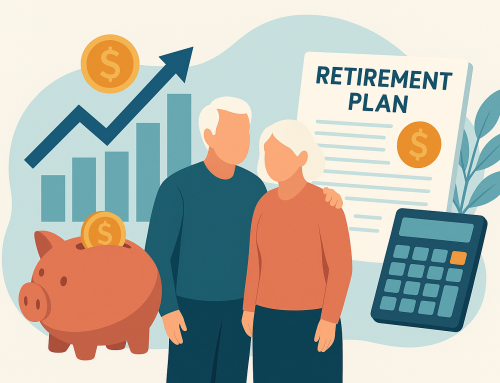
Planning for retirement means giving yourself the freedom to choose how you want to live later in life—without financial stress. Whether you’re just starting your career or nearing retirement, knowing how to plan effectively can make all the difference. This guide walks you through the key steps, tools to use, and various sources of income to help you enjoy a comfortable and secure retirement.
The Steps to Plan for Retirement
Planning for retirement is like building a house: you need a solid foundation before layering on the rest. Here are the main steps to follow:
-
Identify all potential future sources of income
-
Define your retirement goals (when to retire, and under what circumstances)
-
Calculate how much you need to save annually to reach those goals
-
Factor in inflation, life expectancy, and early retirement risks
-
Build a concrete plan using the right tools and professional advice
Identify Your Retirement Income Sources
The first step is listing the income you’ll rely on once you retire. These typically fall into three categories: government benefits, employer-sponsored plans, and personal savings.
Government Income Sources
Quebec Pension Plan (QPP)
A public pension you contribute to during your working life. Your monthly amount depends on your earnings and the number of years you contributed. You can start receiving it at age 60, but the later you claim (up to 70), the higher the monthly payment.
Old Age Security (OAS)
This federal program provides monthly payments starting at age 65, regardless of your work history, provided you’ve lived in Canada for a qualifying period.
Guaranteed Income Supplement (GIS)
An additional benefit for low-income OAS recipients to ensure a minimum level of income in retirement.
Allowance and Survivor’s Allowance
These apply to people aged 60 to 64 who live with an OAS-GIS recipient, or to widows/widowers with low income.
Employer-Sponsored Income Sources
Pension Plans
Some employers offer defined benefit or defined contribution pension plans as a supplement to public pensions.
Group RRSP (Registered Retirement Savings Plan)
Similar to an individual RRSP but managed through your employer, often with company matching contributions.
VRSP (Voluntary Retirement Savings Plan)
Ideal for small businesses and self-employed workers. Contributions are automatic and management fees are generally lower.
Personal Savings
RRSP (Registered Retirement Savings Plan)
A key retirement savings tool in Canada. Contributions are tax-deductible, and growth is tax-deferred until withdrawal.
TFSA (Tax-Free Savings Account)
Perfect for flexible retirement savings. Withdrawals are tax-free, making it an excellent complement to RRSPs.
Annuities
These are financial products that provide guaranteed income for a set period or for life, in exchange for an upfront investment.
Reverse Mortgages
Available to homeowners aged 55+, this option lets you borrow against your home’s value without selling it, while continuing to live there.
Other
This includes stock investments, rental property income, business income, or dividend earnings.
Define Your Retirement Goals
Your goals shape the kind of retirement you want to live. Ask yourself:
-
At what age do I want to retire?
-
Do I have specific projects (travel, buying a second home)?
-
Do I envision a modest, comfortable, or luxurious retirement?
-
Will I still have debts or dependents?
Create a rough budget for your retirement expenses—housing, food, healthcare, leisure, transportation, taxes, etc. A common benchmark is to aim for 70% to 80% of your current income to maintain your lifestyle.
Calculate How Much You Need to Save Annually
Once you’ve defined your goals, turn them into numbers. Tools like SimulRetraite by Retraite Québec or the Government of Canada’s Retirement Income Calculator can help.
Key elements to consider:
-
Your current age
-
Your target retirement age
-
Expected retirement income
-
Current savings
-
Anticipated investment returns
-
Inflation rate
💡 Real-life example:
If you’re 40, plan to retire at 65 with $40,000/year, and already have $30,000 in savings, you’ll need to save about $7,000 per year (based on moderate return assumptions).
Know Yourself to Plan Better
The Consequences of Early Retirement
Retiring before 65 may seem appealing but reduces:
-
QPP and OAS benefits
-
Contribution years
-
Total accumulated savings
Carefully evaluate the long-term impact of retiring early.
The Role of Inflation
Even a 2% annual inflation rate erodes purchasing power. What costs $1,000 today could cost over $1,800 in 30 years.
The Rule of 72
This rule estimates how long it takes for your money to double based on interest rate:
E.g., 72 ÷ 6% return = 12 years to double your capital.
Life Expectancy
Today, life expectancy at retirement is around 85, and many people live to 90 or 95. It’s best to plan for a long retirement.
FAQ: Planning for Retirement
When should I start planning for retirement?
As early as possible! Ideally with your first income. Small amounts saved early can grow significantly thanks to compound interest.
Can I live off QPP and OAS alone?
For most people, these cover only 30–40% of their needs. Complementary savings are essential.
Is my employer required to offer a pension plan?
No, but some offer a VRSP or group RRSP. Check with your employer and take advantage if available!
What’s the difference between RRSP and TFSA?
RRSP reduces your taxes today; TFSA allows for tax-free withdrawals later. Both are useful and complementary.
How can Atfinance help me plan for retirement?
At Atfinance , we assess your income, goals, and opportunities to build a tailored plan. Whether optimizing your RRSP, selecting investments, or preparing for early retirement, we support you at every step.
Conclusion
Retirement planning is a life project. The earlier you start, the easier and more reassuring it becomes. By understanding your income sources, future needs, and the right savings strategies, you can enjoy a retirement that is free, happy, and aligned with your dreams.
Want personalized guidance?
📞 Contact Atfinance for a free consultation and set yourself up for a successful retirement.







